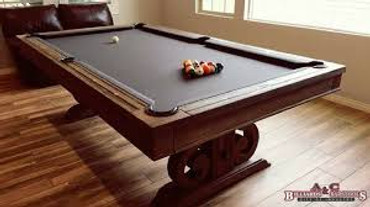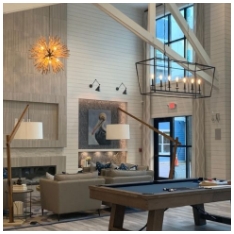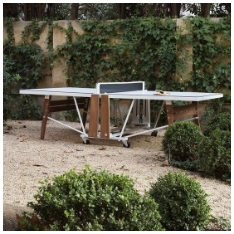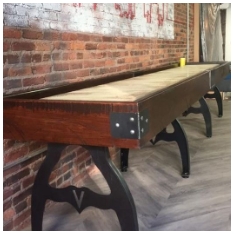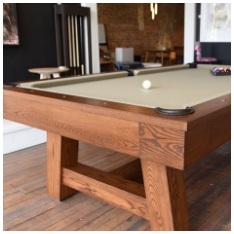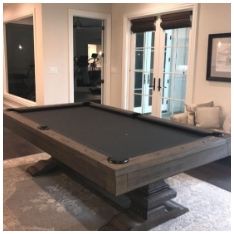Pool tables are central to cue sports and come in a range of sizes. Choosing the right one involves understanding industry standards, especially if you're furnishing a game room or preparing for regulated play. This article provides a comprehensive breakdown of standard pool table sizes and factors that affect your decision when buying one.
Why Pool Table Size Matters
The size of a pool table directly impacts gameplay, strategy, and even room layout. A table that is too small may hinder skill development, while an overly large one can make casual play frustrating. Standard dimensions ensure consistency for competitive environments and home enjoyment alike.
What Is the Standard Size of a Pool Table?
Regulation and Tournament Standards
The term "standard size" typically refers to tables approved for tournament play. According to the World Pool-Billiard Association (WPA) and other governing bodies, the standard size for a regulation pool table is:
- 9 feet (100 inches by 50 inches of playing surface)
This size is used in professional and international competitions. The table’s playing surface should have a 2:1 length-to-width ratio.
Bar and Pub Table Standards
While the 9-foot table is the professional standard, most bars and pubs opt for more compact tables to fit within limited space. The most common bar table sizes include:
- 7 feet (78 inches by 39 inches playing surface)
- 6 feet (66 inches by 33 inches playing surface)
These tables are often coin-operated and designed for casual or quick games. The reduced size means tighter ball clusters and less emphasis on long shots.
Home and Recreational Sizes
For residential settings, the most popular pool table sizes are:
- 8 feet (88 inches by 44 inches) – Sometimes referred to as “standard home size”
- 7 feet (78 inches by 39 inches) – A common choice for smaller game rooms
While not regulation size, these tables offer a balance between challenge and space management.

Slate Bed vs. MDF: Does It Affect Size?
Pool tables are constructed with different materials, most notably slate and MDF (medium-density fiberboard). While both types can be built to standard sizes, there are performance differences worth noting:
- Slate Bed Tables: Often found in 8-foot or 9-foot sizes; heavier, more accurate, and preferred for tournaments.
- MDF Tables: Lighter and more affordable; commonly found in smaller sizes like 6-foot or 7-foot.
The table’s core material does not affect standard dimensions but can influence the weight, portability, and price.
Cushion and Pocket Specifications
While the playing surface dimensions define the size, the cushions (rails) and pocket widths also follow standard specifications to ensure uniform play:
- Corner Pocket Width (at mouth): ~4.5 inches
- Side Pocket Width (at mouth): ~5.0 inches
- Cushion nose height: 63.5% of a 2.25" ball diameter (~1.43 inches)
These measurements remain consistent across most professional-grade pool tables.
Choosing the Right Size for Your Needs
Selecting the correct pool table size depends on several personal and spatial factors:
7-Foot Table – For Compact Rooms
Ideal for casual players or homes with limited space, a 7-foot table provides a solid balance of playability and fit. It’s also the common size found in bars and taverns.
8-Foot Table – Best for Recreational Home Play
This size is the most common choice for households. It allows room for skill development without demanding as much space as a 9-foot table.
9-Foot Table – For Competitive Players
A full-size 9-foot table is optimal for advanced players or those training for tournaments. It demands more skill, especially in long-distance shots and cue ball control.
Standard Cue Sizes and Their Relevance
Pool cues generally come in different lengths to accommodate varying player preferences and room sizes. The standard cue length is 58 inches, but here are the common types:
- 48 inches – For tight corners or junior players
- 52 inches – Useful in slightly restricted spaces
- 58 inches – Professional and standard home play
Room planning must account for cue length in every direction around the table.
Installation and Weight Factors
When choosing a standard pool table size, consider the weight and assembly process, particularly for slate models:
- A 9-foot slate pool table can weigh between 800–1000 lbs
- Assembly may require professional installation
- Flooring should be checked for structural support in upper levels
Smaller MDF tables are significantly lighter and easier to move, but they trade off accuracy and durability.
International Variations in Table Sizes
Different regions may use slightly altered dimensions, especially in games like snooker and English pool, which have their own standards:
- English Pool Tables: Usually 6 or 7 feet
- Snooker Tables: Full-size is 12 feet by 6 feet
- Carom Billiards Tables: No pockets, typically 10 feet long
Make sure to verify the intended use before purchasing a table listed in non-U.S. standards.
Summary: What Is the Standard Size of a Pool Table?
To recap:
- The standard pool table size for tournament play is 9 feet (100" x 50")
- 8-foot tables are the most common for home use
- 7-foot tables are standard in bars and small spaces
- Room dimensions, cue length, and table material should influence your choice
- Consistency in pocket size and cushion angle matters for fair gameplay
Final Thoughts
Understanding pool table dimensions helps in making an informed decision for your space and skill level. Whether you’re aiming for casual play or preparing for competitive matches, choosing the right size table is key to enjoying the game.
